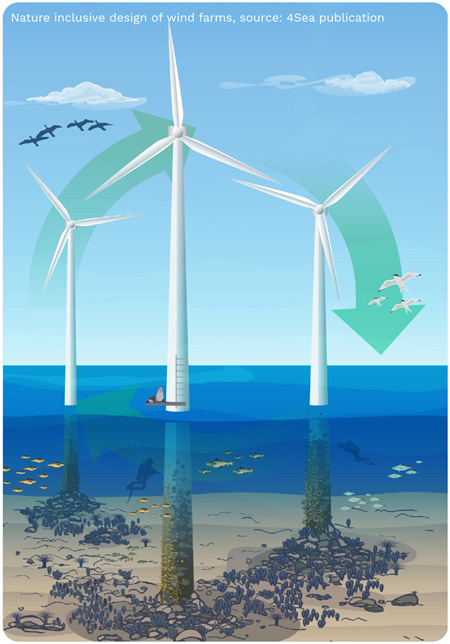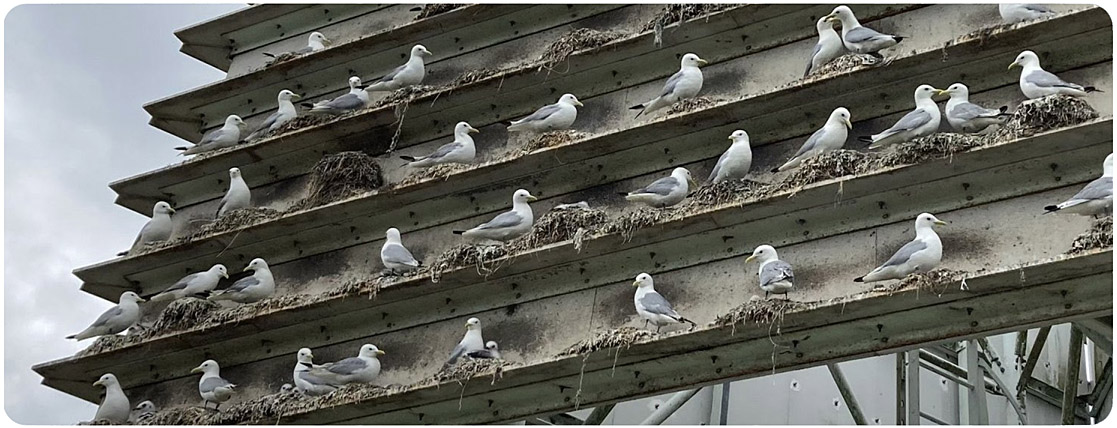The Belgian part of the North Sea has a crucial role to play in the triple planetary crisis of climate change, biodiversity loss and the pollution and waste problem. A climateneutral and biodiverse North Sea is possible with careful consideration, planning, and development of renewable energy activities.
 The Belgian 4Sea coalition (Bond Beter Leefmilieu, Greenpeace Belgium, Natuurpunt and WWF-Belgium) strives to make the development of wind energy in the Belgian part of the North Sea beneficial for both nature and climate. To that end, nature protection, conservation and restoration should be a top priority in the design, construction, operation and decommissioning of wind farms in Belgian offshore wind zones, some of which are (partly) located in protected Natura 2000 areas.
The Belgian 4Sea coalition (Bond Beter Leefmilieu, Greenpeace Belgium, Natuurpunt and WWF-Belgium) strives to make the development of wind energy in the Belgian part of the North Sea beneficial for both nature and climate. To that end, nature protection, conservation and restoration should be a top priority in the design, construction, operation and decommissioning of wind farms in Belgian offshore wind zones, some of which are (partly) located in protected Natura 2000 areas.
Coalition with the Belgian Offshore Platform and SeaCoop
To prioritize nature in offshore wind farms and fully adopt a nature inclusive, circular design of offshore wind farms, 4Sea co-signed a letter of intent with two crucial offshore wind stakeholders. Since June 2021, the Belgian Offshore Platform, an association of investors and owners of wind farms in the Belgian part of the North Sea, and 4Sea work together to maximize the protection, enhancement and restoration of the biodiversity values of the North Sea. Since June 2023, SeaCoop also works together with 4Sea.
SeaCoop cvso is the Belgian renewable energy community founded by 33 citizen cooperatives for renewable energy, all of which are members of REScoop Flanders or REScoop Wallonia. After all, a socially fair and just energy transformation plays a critical role in how we will reach our climate and biodiversity targets.
Nature inclusive design of wind farms4
Based on the findings of more than 10 years of scientific research on the effects of the installation of wind turbines on the marine ecosystem (WinMon.BE), 4Sea is convinced that further development of offshore wind energy can and must go together with the protection, strengthening and restoration of the marine environment and marine biodiversity. In the Belgian part of the North Sea, we strive for optimisation and customisation, always starting from the biodiversity values to be protected, a critical step towards measures to solve the climate and biodiversity crises.
The following points are important in the design, construction, operation and decommissioning of wind farms in the North Sea. First and foremost, wind farms in Natura 2000 areas are an exception and can only be developed under strict conditions, including the mandatory appropriate assessment as stipulated in the Habitats Directive. Second, further investment in scientific research and innovation is necessary to minimize the impact on nature and to maximize the opportunities for nature. Third, nature-inclusive design of (new) wind farm constructions should be the norm. The wind farm and its infrastructure must mitigate any negative effects and, where possible, create positive effects for biodiversity. Lastly, renewable energy production must be future-proof. This is heeding the urgent need for a dialogue with the sector on how to combine the improvement of nature values and renewable energy production, within a circular approach from design to decommissioning, including the demand for raw materials.

Nesting sites for seagulls. Photo: ©Tyne Kittiwakes
Energy island in the Belgian part of the North Sea
The Princess Elisabeth Island is an extension of the electricity grid in the Belgian part of the North Sea. It connects wind farms from the sea to the mainland and creates new connections with neighboring countries. A consortium comprising Belgian marine construction companies DEME and Jan De Nul has already started preparing the site where it will build the caissons. In the meantime, Elia is putting the final touches on a nature-inclusive design for the island. Together with various external experts from science, policy and civil society, the island design was examined to determine which items could be adjusted or added with a view to strengthen, enhance and boost biodiversity on and around the island.
4Sea hopes that the current societal paradigms of geopolitical instability and energy supply security will not rush the construction of any energy infrastructure, including the energy island, at the expense of nature and biodiversity. We must prevent any large-scale and long-life offshore structure from lying unused for years. Especially since the real bottleneck in the development of offshore energy lies in landing the generated offshore power and the connection to our electricity grid. The mainland electricity grid needs an urgent update to increase the stability of the power grid in the region, Belgium and Europe, to ensure the safe landfall of energy from current and future offshore wind farms, and to realise current and future electrical interconnections with other countries, which will positively affect the electricity price. Therefore, the development of 2 priority infrastructure projects for Belgium is crucial, namely the reliable networks of Ventilus through West Flanders and Boucle du Hainaut through Wallonia.
Marine spatial planning
Despite the limited space, it is quite busy in, on and around the Belgian part of the North Sea. Various users are looking for space. Think of fisheries and aquaculture, military activities, sand and gravel extraction, shipping, ports, renewable energy production, pipelines and cables, tourism and recreation, scientific research… Belgium has been one of the first countries in the world to draft a marine spatial plan, back in 2014. This plan legally determines, for a period of 6 years (8 years from the marine spatial plan 2026-2034 onwards), where each activity is (or isn’t) allowed at sea.
The existing Natura 2000 areas were already designated in the marine spatial plan of 2014, but until now these areas lack effective protection. The new areas for offshore energy, as indicated in the marine spatial plan for 2020-2026, are partly situated in the Natura 2000 areas.
The limited space for offshore activities, combined with Belgium's leading position in offshore wind, results in many countries watching us with great interest. That's why we need good, ecosystem-based marine spatial planning in the entire North Sea area, with regards to both the necessary transition from fossil to renewable energy in a cross-border offshore and onshore renewable energy network, and to the protection of marine biodiversity in a Natura 2000 network. This needs to be in line with relevant national, regional and international legislation and biodiversity targets (e.g., the Kunming-Montreal Global Biodiversity Framework) and relevant regional conservation initiatives (e.g. Natura 2000 directives, Marine Strategy Framework Directive). By endorsing nature-inclusive, circular renewable energy, possible conflicts between nature and climate goals are mitigated or even avoided. The goal of a climate-neutral and biodiverse North Sea can be achieved more quickly.
There is a great need for an overview in the form of an energy plan for Belgium, embedded in a European context, including the North Sea waters. This way we can focus on how we can solve the energy issue in the best possible way, in terms of modularity, flexibility and circularity. At sea, this energy plan must certainly coincide with a biodiversity plan, to protect, strengthen and restore nature. As such, the (partial) solution to the climate crisis does not amplify the biodiversity crisis in the North Sea.

Northern gannet at the Belgian part of the North Sea. Photo: ©Gert Vanautgaerden
